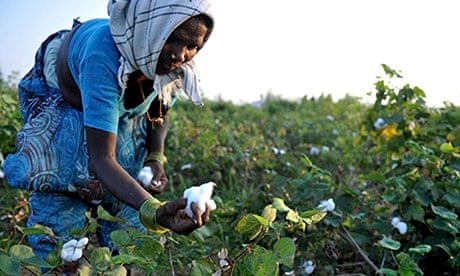Almost 20 years since the launch of the UK's Fairtrade movement, and with €4.8bn (£3bn) in global sales in 2012, India has ambitions to grow the market for Fairtrade-labelled products. Led by local producer groups, the Fairtrade mark in India launches on Thursday, selling Indian-produced Fairtrade-certified products to middle-class consumers in urban centres, including Delhi, Mumbai and Bengaluru.
The Indian adaptation to becoming a Fairtrade-marketing country – versus a producer-only country – reveals a wider issue. "Development" is no longer about the inequities between north and south; it's as much about the inequities within developing countries.
Inequality is on the rise in India. According to the Times of India, the consumption of the top 20% of households grew at almost 3% per year in the last decade, compared with 2% in the 1990s. Meanwhile, the growth in consumption of the bottom 20% of households remains unchanged at 1% per year.
In rural areas, farmers are on the frontline of what is seen as a huge agrarian crisis in India. Some 7.7 million farmers have left agriculture since 2001, according to the last census. Many of them simply become contract workers to larger agribusinesses, seeing a reduction in income from their already meagre poverty-line levels.
There were nearly 14,000 farmer suicides in 2011, with almost 270,000 farmers in India having killed themselves since 1995. Farmers face mounting debt – from the high cost of seed purchases and high production costs – with access to affordable finance still being limited.
Farmers have been feeling the impactof climate change: unpredictable weather patterns and excessive, deficient, or untimely rain have been playing havoc with the crop cycles. Two-thirds of farmer suicides have occurred in cotton-growing regions, such as Andhra Pradesh, which face drier conditions as climate change takes hold.
This context is driving the need to connect with Indian consumers. As one activist said: "It's like the urban middle classes don't want to see poverty. They get in their cars, drive on their expressways, and ignore the reality of the farmers producing their food."
The market potential for Fairtrade, though, appears to be high. As one proxy indicator, the demand for organic food is rising in urban centres with higher awareness of health concerns. Wealthy consumers are also willing to pay 20% more for it, according to research by the Morarka Rural Research Foundation. The question is, can this extend to Fairtrade, where there is no immediate perceived benefit to Indian consumers?
And, more important, how much of a dent in poverty can developing a Fairtrade market in India make? Extending the market through Indian-based consumption would undoubtedly add to the €2.4m (£2m) that Indian farmers and workers received last year through the Fairtrade premium, above what they would otherwise have received in the market. But there are only 120,000 Indian Fairtrade certified farmers – a tiny proportion of the country's producers – and many remain relatively poor. Fairtrade provides some benefits, such as price guarantees and the premium to invest in their communities, but it i's not the sole solution.
Farmers groups in India have been calling for more government intervention, including subsidies, debt relief and better education for their children. The government recently adopted the National Food Security Act, which subsidises food for the poor, but is accused of focusing on larger players while ignoring the real challenges faced by smallholder farming and farmers' contributions to food security for the country.
In India many Fairtrade farmers are also active in the food and seed sovereignty movement, where they see support for smaller farmers – and a strong stance against genetically modified food – as part of the larger solution to their plight.
Consumption models for development have their limitations. They rely on the good intentions of individuals, and can be little more than a token gesture that leaves the status quo intact. Nonetheless, in India, where the consumer society seems more prominent than some mature western markets, it appears to be one potentially significant way that farmers can raise attention to their plight and provide consumers with a way to engage with farmer poverty.
A 2011 Globescan survey found that nearly eight in 10 urban Indians believe business has a role in helping to reduce poverty and protect the environment. Young people in particular, with increased awareness through digital media, have shown an interest in ethical and sustainable business, not just charity.
India's adoption of Fairtrade is a sign of maturity of the movement. It has the power to connect people in ways in which the traditional development model has not always done. But it has yet to make enough of an impact on poverty and the crisis of small farmers worldwide.
Like the global movement for Fairtrade, if Fairtrade in India is to succeed, it will not be through sales alone. It will be through leveraging the conscious consumer to politicise the issue of rural poverty – and of farmers in particular – in the long run resulting in more structural changes to support smallholder agriculture and local economies.

Comments (…)
Sign in or create your Guardian account to join the discussion